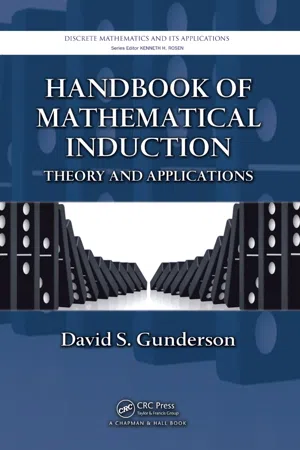Mathematics
Equations and Identities
Equations and identities are fundamental concepts in mathematics. Equations are statements that assert the equality of two expressions, while identities are equations that are true for all values of the variables. These concepts are used extensively in algebra and calculus.
Written by Perlego with AI-assistance
Related key terms
1 of 5
6 Key excerpts on "Equations and Identities"
- eBook - ePub
Common Core Standards for Middle School Mathematics
A Quick-Start Guide
- Amitra Schwols, Kathleen Dempsey, John Kendall(Authors)
- 2013(Publication Date)
- ASCD(Publisher)
Chapter 4Expressions and Equations
. . . . . . . . . . . . . . . . . . . .The introduction to the Common Core standards' high school Algebra domain provides some useful definitions to help differentiate the two mathematical terms expression and equation:An expression is a record of a computation with numbers, symbols that represent numbers, arithmetic operations, exponentiation, and, at more advanced levels, the operation of evaluating a function…. An equation is a statement of equality between two expressions, often viewed as a question asking for which values of the variables the expressions on either side are in fact equal. These values are the solutions to the equation. (CCSSI, 2010c, p. 62)The middle school Expressions and Equations (EE) domain provides a critical bridge between content in the Operations and Algebraic Thinking domain in earlier grades and algebraic content students will encounter in high school. Figure 4.1 shows an overview of the Expressions and Equations domain's clusters and standards by grade level. - Alan Tussy, Diane Koenig(Authors)
- 2018(Publication Date)
- Cengage Learning EMEA(Publisher)
An equation is a statement indicating that two expressions are equal. All equations contain an equal symbol 5. An example is x 1 5 5 15. The equal symbol 5 separates the equation into two parts: The expression x 1 5 is the left side, and 15 is the right side. The letter x is the variable (or the unknown). The sides of an equation can be reversed, so we can write x 1 5 5 15 or 15 5 x 1 5. n An equation can be true: 6 1 3 5 9 n An equation can be false: 2 1 4 5 7 n An equation can be neither true nor false. For example, x 1 5 5 15 is neither true nor false because we don’t know what number x represents. An equation that contains a variable is made true or false by substituting a number for the variable. If we substitute 10 for x in x 1 5 5 15, the resulting equation is true: 10 1 5 5 15. If we substitute 1 for x, the resulting equation is false: 1 1 5 5 15. A number that makes an equation true when substituted for the variable is called a solution; it is said to satisfy the equation. Therefore, 10 is a solution of x 1 5 5 15, and 1 is not. THE LANGUAGE OF ALGEBRA It is important to know the difference between an equation and an expression. An equation contains an 5 symbol; an expression does not. EXAMPLE 1 Self Check 1 Is 25 a solution of 10 2 x 5 35 2 2x? Now Try Problem 19 Evaluate the expression on the left side. Evaluate the expression on the right side. OBJECTIVE 2 Use the addition property of equality. To solve an equation means to find all values of the variable that make the equation true. We can develop an understanding of how to solve equations by referring to the scales shown on the right. The first scale represents the equation x 2 2 5 3. The scale is in balance because the weights on the left side and right side are equal. To find x, we must add 2 to the left side. To keep the scale in balance, we must also add 2 to the right side. After doing this, we see that x is balanced by 5. Therefore, x must be 5.- Raymond A. Barnett, Michael R. Ziegler, Karl E. Byleen(Authors)
- 2012(Publication Date)
- Wiley(Publisher)
Chapter 4 Identities 129 Chapter 4 Identities EXERCISE 4.1 Fundamental Identities and Their Use 1. An identity is an equation in one or more variables in which the left side is equal to the right side for all replacements of the variables for which both sides are defined. 3. sin 2 x + cos 2 x = 1, tan 2 x + 1 = sec 2 x, 1 + cot 2 x = csc 2 x 5. Find tan x: tan x = sin x cos x = 2/ 5 1/ 5 = 2 Find cot x: cot x = 1 tan x = 1 2 Find csc x: csc x = 1 sin x = 1 2/ 5 = 5 2 Find sec x: sec x = 1 cos x = 1 1/ 5 = 5 7. Find sin x: Since csc x = 1 sin x , we can write sin x = 1 csc x ; sin x = 1 csc x = 1 – 10 /3 = – 3 10 Find tan x: tan x = sin x cos x = –3/ 10 1/ 10 = –3 Find cot x: cot x = 1 tan x = 1 –3 = – 1 3 Find sec x: sec x = 1 cos x = 1 1/ 10 = 10 9. Find cos x: Since sec x = 1 cos x , we can write cos x = 1 sec x ; cos x = 1 sec x = 1 –4/ 15 = – 15 4 Find sin x: Since tan x = sin x cos x , we can write sin x = tan x cos x; sin x = tan x cos x = 1 15 – 15 4 = – 1 4 Find cot x: cot x = 1 tan x = 1 1/ 15 = 15 Find csc x: csc x = 1 sin x = 1 –1/4 = –4 11. tan u cot u = tan u 1 tan u Reciprocal identity = 1 Algebra 13. tan x csc x = sin x cos x 1 sin x Quotient and reciprocal identities = 1 cos x Algebra = sec x Reciprocal identity Exercise 4.1 Fundamental Identities and Their Use 130 15. sec 2 x 1 tan x = tan 2 x + 1 1 tan x Pythagorean identity = tan 2 x tan x Algebra = tan x Algebra 17. sin 2 cos + cos = sin 2 cos + cos 1 Algebra = sin 2 cos + cos 2 cos Algebra = sin 2 + cos 2 cos Algebra = 1 cos Pythagorean identity = sec Reciprocal identity Key algebraic steps: a 2 b + b = a 2 b + b 1 = a 2 b + b 2 b = a 2 + b 2 b 19. 1 sin 2 – 1 = 1 sin 2 – 1 Algebra = csc 2 – 1 Reciprocal identity = 1 + cot 2 – 1 Pythagorean identity = cot 2 Algebra 21.- eBook - PDF
- R. Gustafson, Jeff Hughes(Authors)
- 2016(Publication Date)
- Cengage Learning EMEA(Publisher)
The process of finding the equation that describes the words of the problem is called mathematical modeling. The equation itself is often called a mathematical model of the situation described in the word problem. 98. The equation 4x 1 5sx 2 3d 5 9x 1 15 is an iden- tity. 99. Ï7 ,24.5, and p would be included in the solution set for 22x 2 8 5 2s2x 1 8d. 100. The equation x 1 188,424 5 x 1 188,425 has an infinite number of solutions. 101. The solution set of 1 1 1 x 2 3 2 1 1 1 1 x 2 4 2 5 7 is {7}. 102. If y 1 5 1 x 2 p and y 2 5 1, then y 1 5 y 2 when x 5 2p. ©Debby Wong/Shutterstock.com Copyright 2017 Cengage Learning. All Rights Reserved. May not be copied, scanned, or duplicated, in whole or in part. Due to electronic rights, some third party content may be suppressed from the eBook and/or eChapter(s). Editorial review has deemed that any suppressed content does not materially affect the overall learning experience. Cengage Learning reserves the right to remove additional content at any time if subsequent rights restrictions require it. Chapter 1 Equations and Inequalities 98 The following list of steps provides a strategy to follow when we try to find the equation that models an applied problem. A student scores 82, 96, 91, and 92 on four college algebra exams. What score is needed on a fifth exam for the student to earn an average grade of 90? Now Try Exercise 11. Self Check 1 1. Analyze the problem to see what you are to find. Often, drawing a diagram or making a table will help you visualize the facts. 2. Pick a variable to represent the quantity that is to be found, and write a sentence telling what that variable represents. Express all other quantities mentioned in the problem as expressions involving this single variable. 3. Find a way to express a quantity in two different ways. This might involve a formula from geometry, finance, or physics. 4. Form an equation indicating that the two quantities found in Step 3 are equal. - eBook - PDF
- Donald Davis, William Armstrong, Mike McCraith, , Donald Davis, William Armstrong, Mike McCraith(Authors)
- 2018(Publication Date)
- Cengage Learning EMEA(Publisher)
55 r.nagy/Shutterstock.com Chapter 2 CHAPTER CONTENTS Section 2.1 Translating English to Algebra: Expressions, Equations, and Inequalities Section 2.2 Order of Operations and Evaluating Numerical Expressions Section 2.3 Basics of Solving Linear Equations Algebraic Expressions Used in Statistics and Basics of Solving Equations 56 CHAPTER 2 • Algebraic Expressions Used in Statistics and Basics of Solving Equations SECTION 2.1 Translating English to Algebra: Expressions, Equations, and Inequalities When most people think of arithmetic and algebra, what comes to mind is a page full of numbers and letters, with very few words or sentences associated with them. Statistics is a bit different. Many applications in statistics are based on situations that are presented in narrative form, with our task being to translate that narrative into mathematics. In this section, we learn how to translate English into algebra. OBJECTIVE 1 Differentiate between an Expression and an Equation What differentiates arithmetic from algebra is that algebra is the part of mathematics in which letters are used to represent numbers that are either unknown or change from time to time. These letters are known as variables . Commonly used variables include x , y , z , n , t , and so on. In statistics, some variables are denoted by lower case Greek letters such as m (pronounced “mu”), s (pronounced “sigma”), l (pronounced “lambda”), and x (pronounced “kai”). If we place a real number in front or behind a variable, we call that number a coefficient . For our purposes, many of the coefficients will be represented by rational numbers. Together, variables and coefficients make up algebraic terms . Terms that are separated with addition and subtraction signs are called algebraic expressions . - eBook - PDF
Handbook of Mathematical Induction
Theory and Applications
- David S. Gunderson(Author)
- 2014(Publication Date)
- Chapman and Hall/CRC(Publisher)
Part II Applications and exercises This page intentionally left blank This page intentionally left blank 123 In open statements in this part, n is an integer, usually n ≥ 1 unless otherwise specified. For the most part, all necessary notation and definitions used in a ques-tion are given in the same section as the question, so many problems here can be understood without much previous knowledge. With only a few exceptions, nearly all exercises here can be solved by using some form of induction; nearly all exer-cises requiring an infinite form of induction or not requiring induction are clearly identified. Among these exercises one can find an amazing array of classic theorems. Most exercises can be done with only simple algebra; only a few require calculus or more sophisticated machinery. Most questions have solutions, hints, or references in Part III. This page intentionally left blank This page intentionally left blank Chapter 9 Identities The business of concrete mathematics is to discover the equations which express the mathematical laws of the phenomenon under con-sideration; and these equations are the starting-point of the calculus, which must obtain from them certain quantities by means of others. —Comte, Positive philosophy . Identities are tools of every working mathematician. Standard identities involv-ing simple sums, products, fractions, or exponents are used by every student; it may be amazing to see how many of these can be proved by induction. Some of the more useful identities involve binomial coefficients or trigonometry, and many of these also can be proved by mathematical induction. Exercises below are often roughly grouped by category; however, many exercises could easily fall into more than one category. Many of the identities below have “proofs without words”, that is, a pictorial representation. The interested reader can find many of these in Roger B. Nelsen’s two delightful books [403], [404], available from the MAA.
Index pages curate the most relevant extracts from our library of academic textbooks. They’ve been created using an in-house natural language model (NLM), each adding context and meaning to key research topics.





